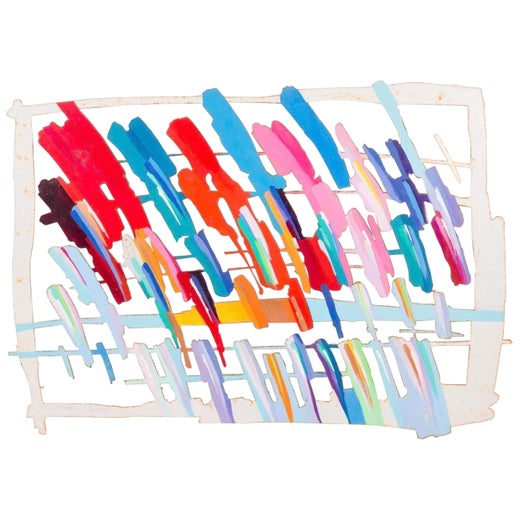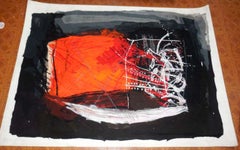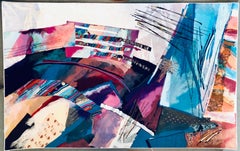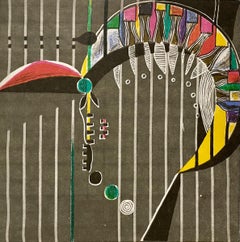Want more images or videos?
Request additional images or videos from the seller
1 of 6
Calman ShemiModernist Israeli Soft Tapestry Wall Hanging Rug Calman Shemi
Price:$2,025
$2,800List Price
About the Item
- Creator:Calman Shemi (1939, Argentinian)
- Dimensions:Height: 71 in (180.34 cm)Width: 45 in (114.3 cm)
- Medium:
- Movement & Style:
- Period:
- Condition:minor wear and light soiling. with bright vibrant colors.
- Gallery Location:Surfside, FL
- Reference Number:1stDibs: LU38212217972
Calman Shemi
Calman Shemi was born in Argentina in 1939. He studied sculpture and ceramics at the School of Mendoza in Argentina. In 1961, Shemi emigrated to Israel, and in 1963 he began studying sculpture with Rudi Lehman. He created his first "soft" paintings in 1977. Since 1978, he has worked primarily in serigraphy and acrylic paintings. In 1999, Shemi developed the "windows" and the "lacquer" painting techniques. The "window" or "shadow box" painting is a unique form of artistic expression. First Shemi creates a painting in a wooden box. After completion of the painting, he affixes a customized wooden frame to the box. This unusual technique results in the illusion of looking through a window to the landscape or into a room. The frame is then covered with silver or gold leaf and finally lacquered. The final result is a piece of art that emphasizes the contrast between the outside level and the painting within a deeper level.
Lacquer paintings are also one of Shemi's original creations. These works usually begin as an exciting abstract design or still-life painted on wood or on a metal panel that has been covered in layers of gold and/or silver leaf. After the paint has dried, the painting is gilded with many layers of lacquer. Between each layer of lacquer the surface is hand polished to give it a metallic finish, resulting in a luminous effect.
Remarkably, artist Shemi has had 71 one-man shows all around the world, including Israel, France, Singapore, Nigeria, Australia, Japan, Canada, Spain Germany, the United States and elsewhere. His works are displayed in the Spertus Museum of Judaica, the Fashion Institute of Chicago, Citibank in New York, the Hebrew University in Jerusalem, just to name a few.
About the Seller
4.9
Platinum Seller
Premium sellers with a 4.7+ rating and 24-hour response times
Established in 1995
1stDibs seller since 2014
1,812 sales on 1stDibs
Typical response time: 1 hour
Authenticity Guarantee
In the unlikely event there’s an issue with an item’s authenticity, contact us within 1 year for a full refund. DetailsMoney-Back Guarantee
If your item is not as described, is damaged in transit, or does not arrive, contact us within 7 days for a full refund. Details24-Hour Cancellation
You have a 24-hour grace period in which to reconsider your purchase, with no questions asked.Vetted Professional Sellers
Our world-class sellers must adhere to strict standards for service and quality, maintaining the integrity of our listings.Price-Match Guarantee
If you find that a seller listed the same item for a lower price elsewhere, we’ll match it.Trusted Global Delivery
Our best-in-class carrier network provides specialized shipping options worldwide, including custom delivery.You May Also Like
Large Woven Wool Rug / Wall Art-Tapestry "Essence of Absurd #2" by Calman Shemi
By Calman Shemi
Located in San Diego, CA
Large soft painting woven wool rug / wall art-tapestry "Essence of Absurd #2" by Argentinian-Israeli artist Calman Shemi, circa 1984. This a vibrant and expressive tapestry that sho...
Category
Mid-20th Century Israeli Modern Tapestries
Materials
Natural Fiber, Textile
$2,950
H 0.25 in W 74.5 in D 51.5 in
Structure 11 Acrylic On Wool Tapestry
By Calman Shemi
Located in Lake Worth Beach, FL
Structure #11 acrylic on wool.
Hand signed and titled on verso.
Calman Shemi, sculptor and painter, was born in Argentina in 1939. A graduate of the school of Sculpture and Cerami...
Category
1990s Abstract Mixed Media
Materials
Wool, Acrylic
Calman Shemi Environmental Sculptures Signed Contemporary Modern Wall Tapestry
By Calman Shemi
Located in Keego Harbor, MI
A contemporary modern abstract tapestry titled "Environmental Sculptures" by Argentinian artist Calman Shemi. Hand signed and titled on verso with an annotation of 7/9. Circa 1980s. ...
Category
Vintage 1980s Unknown Tapestries
Materials
Tapestry
$4,000
H 52 in W 66 in D 0.5 in
"Five PM #4" Wool Felted Tapestry, 20th Century
By Calman Shemi
Located in Astoria, NY
Calman Shemi (Argentinean/Israeli, b. 1939), "Five PM #4", Wool Felted Tapestry, signed lower left, signed and titled to verso. 95.5" L x 47.75" W. Provenance: From a 5th Avenue est...
Category
20th Century Contemporary More Art
Materials
Wool, Tapestry
Through the Window, Colorful Abstract Lithograph by Calman Shemi
By Calman Shemi
Located in Long Island City, NY
Artist: Calman Shemi, Argentine (1939 - )
Title: Untitled I
Medium: Lithograph, signed and numbered in pencil
Edition: HC 60/450
Size: 34.5 in. x 26 in. (87.63 cm x 66.04 cm)
Category
Late 20th Century Abstract Abstract Prints
Materials
Lithograph
$720 Sale Price
20% Off
H 34.5 in W 26 in
Calman Shemi Large Format Wall Tapestry, 1978
By Calman Shemi
Located in Miami, FL
Monolithic wool wall tapestry by artist Calman Shemi dated 1978. Can be hung horizontal or vertical.
Calman Shemi
Argentine/ Israeli
1939 -
Tapestry
Signed and dated near lowe...
Category
Vintage 1970s Argentine Modern Tapestries
Materials
Wool
1970s Abstract Design Hand made Wool Tapestry - Czechoslovakia
Located in Praha, CZ
- perfect original condition, bright colours
- marked
jr
Category
Vintage 1970s Czech Mid-Century Modern Tapestries
Materials
Wool
$669 Sale Price
20% Off
H 26.78 in W 43.31 in D 1.19 in
A Large Modernist Abstract Tapestry by Mathieu Mategot
By Mathieu Matégot
Located in Atlanta, GA
A modernist wool woven tapestry designed by French artist and designer Mathieu Mategot (1910-2001) circa 1960s. The piece is signed with Matégot and monogrammed TMP fino (Manufactur...
Category
Vintage 1960s Portuguese Mid-Century Modern Tapestries
Materials
Canvas, Wool
Bold Organic Abstract Pattern Wall Hanging Tapestry or Floor Covering
Located in Ferndale, MI
This is a beautiful and striking wool tapestry is in fine condition . The graphic abstract organic images brought to life as a tapestry in the rich hues of Orange Yellow eggplant la...
Category
Mid-20th Century American Mid-Century Modern Tapestries
Materials
Wool
Mathieu Matégot - Oberon, tapestry, french, modern, abstract, wool, design
By Mathieu Matégot
Located in London, GB
Mathieu Matégot (1910-2001)
Oberon
c.1950s
wool tapestry, Manufactura de Tapeçarias de Portalegre; (possibly) no. 2
125 x 202 cm
signed ‘Matégot’ and with the Manufactura de Tapeçarias de Portalegre monogram (lower right); titled, inscribed, numbered and signed (workshop label on the verso)
Price:
$18,000 USD
Provenance:
Barry Friedman Ltd, New York (stock no. BF19387)
Notes:
Mathieu Matégot was a Hungarian-born French designer, architect and artist. After studying at Budapest's School of Fine Arts in 1929, Matégot travelled across Italy and the USA until settling in Paris in 1931 where he worked as a set designer, window dresser and tapestry maker.
Matégot volunteered for the French resistance at the start of the Second World War, only to be captured by the Nazis. A dreadful fate for most, however, it was during his time as a prisoner of war that the artist discovered metalworking techniques (such as Rigitulle) which he later patented and became renowned for. Upon his release, Matégot was awarded French citizenship.
After the war, the artist's interest in tapestry was renewed after being introduced to contemporary tapestry revivalist, Jean Lurçat. However, in order to make ends meet, Matégot pursued furniture design; he established a workshop in Paris and dedicated his time to translating the groundbreaking metal techniques into popular handcrafted objects.
In 1959, Matégot abandoned furniture design and focused exclusively on his passion for abstract tapestries. He continued his work as a pioneer of French Modern tapestry...
Category
1950s Abstract More Art
Materials
Tapestry
Price Upon Request
H 49.22 in W 79.53 in
More From This Seller
View AllLarge Calman Shemi Art Textile Stendhal #2 Israeli Soft Tapestry Wall Hanging
By Calman Shemi
Located in Surfside, FL
this is a bright vibrant abstract wall hanging tapestry by Calman Shemi. I believe the material is wool with a linen backing but i am not positive. it can also be used as a floor rug...
Category
1980s Abstract Expressionist Mixed Media
Materials
Mixed Media
Fiber Art Collage Israeli Modernist Vibrant Colorful Tapestry Wall Hanging Rug
By Smadar Livne
Located in Surfside, FL
Smadar Livne, an Israeli born artist, is currently living and creating in Owings Mills, Maryland. An award winning artist, she is recognized as one of today’s leading Judaica artists. Educated at Haifa University, Livne has degrees in art, literature, and architecture. She has continued her education of philosophy through Baltimore Hebrew University. Portraying scenes from her life and learning is what gives her work an edge. Livne’s works are vibrant and exciting, and express the joy that Livne sees in life. Not only are the works beautiful, but subtle messages are also painted into each piece, and require time for observation and reflection. Technique sets Livne apart from the rest. Using bold, bright colors and wide strokes, she adds other items in a layering technique. The eye catching result contains layers of paint, fabric, wool and other materials objects, and meaning. Following in the manner of Calman Shemi and before him Kopel Gurwin, Itche Mambush and Georges Goldstein...
Category
20th Century Abstract More Art
Materials
Textile
Feminist Surrealist French Abstract Colorful Lithograph Print Myriam Bat Yosef
Located in Surfside, FL
Myriam Bat-Yosef
Surrealist abstract lithograph print in colorful abstract shapes and shades
Hand signed and dated 1971.
sheet measures 9.25 X 9.25 inches
The envelope and the Peter Buch poster is just for provenance and is not included in this sale.
Myriam Bat-Yosef, whose real name is Marion Hellerman, born on January 31, 1931 in Berlin, Germany to a Jewish family from Lithuania, she is an Israeli-Icelandic artist who paints on papers, paintings, fabrics, objects and human beings for performances. Myriam Bat-Yosef currently lives and works in Paris. In 1933, her family fleeing the Nazi Holocaust, Miriam Bat-Yosef emigrates to Palestine and settles in Jaffa. In 1936, she suffers a family tragedy, her father, militant Zionist, is called to fight, still recovering from an operation of appendicitis. The incision will become infected, antibiotics did not exist yet, and her father will die in the hospital after 9 months of suffering.
Myriam and her mother leave Palestine to live in Paris for three years. French is Myriam's first school language. In 1939, still fleeing Nazism, she returned to Palestine, leaving France by the last boat from Marseille. She moved to Tel Aviv with her mother, aunt and maternal grandmother.
In 1940, she began attending the Academy of Fine Arts in Tel Aviv and took her name as an artist, Bat-Yosef, which means Joseph's daughter in Hebrew, as a tribute to her father. In 1946, Myriam graduated as a kindergarten teacher but wanted to be an artist. Her mother enrolled her in an evening school to prepare a diploma of art teacher. At 19, she performs two years of military service in Israel.
In 1952, with a pension of $50 a month that her mother allocated, she went to study at the Beaux-Arts in Paris. To survive, she has several activities while studying. In 1955, she had her first solo exhibition, at the Israeli Club on Wagram Avenue in Paris. Many artists, such as Yaacov Agam, Yehuda Neiman Avigdor Arikha, Raffi Kaiser, Dani Karavan and sculptors Achiam and Shlomo Selinger attended the opening .
In 1956, she enrolled at the School of Fine Arts in Florence. This is where she meets the painter Errô. They share an icy studio in winter. Myriam moves to Milan with friends. She organizes a joint exhibition with Erro, one room each, at the Montenapoleone gallery. Her works are admired by the sculptor Marino Marini and the painters Renato Birolli and Enrico Prampolini. Myriam and Erro exhibit in Rome, Milan, Florence and meet many personalities: Alain Jouffroy and his wife, the painter Manina, Roberto Matta and his wife Malitte, textile artist who was one of the founders of the Pompidou Center. Back in Paris, Myriam and Erro get married, which allows Myriam to avoid being called into the Israeli army during the Suez Canal War.
In 1957, Myriam and her husband went to Iceland. Myriam works in a chocolate factory. Having enough money, she starts producing art again. She exhibited in Reykjavik's first art gallery. She meets the artist Sigridur Bjornsdottir, married to the Swiss painter Dieter Roth .
In 1958, Myriam and her husband leave for Israel. They exhibit in Germany, then in Israel. Back in Paris, the couple became friends with artists of the surrealist movement, such as Victor Brauner, Hans Bellmer, the sculptor Philippe Hiquily, Liliane Lijn, future wife of Takis and photographer Nathalie Waag. Erro and Myriam have a daughter on March 15, 1960, named Tura, after the painter Cosmè Tura, but also close to the Icelandic Thora or the Hebrew Torah. Bat-Yosef’s complex trajectory throughout the 20th century is linked as much to the transnational history of what was for a time called the School of Paris as it is to a certain legacy of Surrealism. Her work features the same idea of resolving antinomies that also defined the spirit of surrealism, and is enhanced with her readings of the Kabbalah and her spiritual grounding in Taoism. However, while there are reasons for her approach to be associated with the process of the ready-made, it is important to consider the immediate intrication of these works with her practice of performance, during which the body itself is also painted – a feminist response to Yves Klein’s Anthropometries (1960) and an echo of the happenings which Jean-Jacques Lebel organised at the time in Paris.
In 1963, Erró told Myriam that if she wants to be a painter, she can not be his wife. Myriam chose to be a painter and the couple divorced in 1964. Since that time, Myriam Bat-Yosef has exhibited in many countries: Europe, United States, Japan, etc.
Although long in the shadows, the work of Myriam Bat-Yosef has been greeted by many artists and personalities: Anaïs Nin, Nancy Huston, André Pieyre of Mandiargues, José Pierre, René de Solier , Jacques Lacarrière, Alain Bosquet, Pierre Restany, Sarane Alexandrian and Surrealist André Breton who, after a visit to her studio, confided to having been intrigued by its phantasmagorical dimension. She was included in the book Pop Art and Beyond: Gender, Race, and Class in the Global Sixties by Mona Hadler and Kalliopi Minioudaki. Extract "World Citizen, Artist of the Pop Era Sarah Wilson; Why do we know so little of Myriam Bat-Yosef, the most important female Israeli artist of the Pop era? Issues of identity and sexuality feature constantly in her work. She exhibited internationally from Reykjavik to Tokyo; she had two shows at Arturo Schwarz’s famous Dada/surrealist gallery in Milan; she participated in feminist art events in Los Angeles. Above all, in 1971, she conceived Total Art, a Pop Gesamtkunstwerk inside and outside the Israel Museum, Jerusalem. Painter, performer, and installation artist, she was also a lover, wife, and mother. Of Lithuanian-Jewish descent, she was close to the family of philosopher Emmanuel Levinas. An émigré in Paris she would repudiate a national passport, participating in Garry Davis’s short-lived “World Citizens” movement. She continues the lineage of women surrealist artists: Valentine Hugo, Leonor Fini, Dorothea Tanning, Leonora Carrington, Unica Zürn, Jane Graverol, Toyen, Alice Rahon...
Category
1970s Surrealist Abstract Prints
Materials
Lithograph
Israeli Surrealist Judaica Abstract Lithograph Naftali Bezem
By Naftali Bezem
Located in Surfside, FL
Naftali Bezem (Hebrew: נפתלי בזם; born November 27, 1924) is an Israeli painter, muralist, and sculptor.
Bezem was born in Essen, Germany, in 1924. His early adolescence was spent...
Category
20th Century Modern Prints and Multiples
Materials
Lithograph
Rare Israeli Surrealist Judaica Abstract Lithograph Naftali Bezem
By Naftali Bezem
Located in Surfside, FL
Fine lithograph on deckle edged French Arches paper. Pencil signed and numbered from edition of 150.
A Surrealist Judaica scene of a bearded man (Rabbi) in a boat with Shabbat candlesticks. with blindstamp from Editions Empreinte in Paris, France. (They published, Jean Michel Folon, Sempe, Raoul Ubac, Raymond Savignac, Cesar, Bengt Lindstrom , Paul Aizpiri and many other modern masters.
Naftali Bezem (Hebrew: נפתלי בזם; born November 27, 1924) is an Israeli painter, muralist, and sculptor.
Bezem was born in Essen, Germany, in 1924. His early adolescence was spent under Nazi oppression, in constant fear for the safety of his parents, who perished in the Holocaust in the Polish Auschwitz concentration camp. Naftali emigrated to Mandate Palestine in 1939, at the age of fourteen with a Youth Aliyah group.
From 1943 to 1946, he studied art at the Bezalel Academy of Art and Design in Jerusalem with Israeli painter Mordecai Ardon. He then spent three years studying in Paris.His most famous public works include a wall relief at Yad Vashem in Jerusalem and the ceiling mural in the main reception room at the President's Residence, Jerusalem.In 1957, Bezem was a co-recipient of the Dizengoff Prize for Painting.
Group Exhibitions
Orit Art Gallery, Tel Aviv
Artists: Yosef Zaritsky, Marcel Janco, Lea Nikel, Robert Baser, Bezem, Michael Druks,
Israeli Painting (Watercolors and Gouache)
Artists:
Pinchas Abramovich, Bezem, Naftali Nachum Gutman, Haim Gliksberg, Mordechai Levanon, Avigdor Stematsky, Avshalom Okashi, Yehiel Krize...
Category
20th Century Modern Figurative Prints
Materials
Lithograph
70's Large Colorful Abstract Expressionist Art Protis Tapestry Wool Wall Hanging
By Robert Freimark
Located in Surfside, FL
Art Protis Wall Tapestry
Robert Freimark (1922 - 2010)
Bob Freimark was active/lived in Ohio, California, Michigan. Robert Freimark is known for abstract expressionist painting, ...
Category
1970s Abstract Expressionist Mixed Media
Materials
Wool




